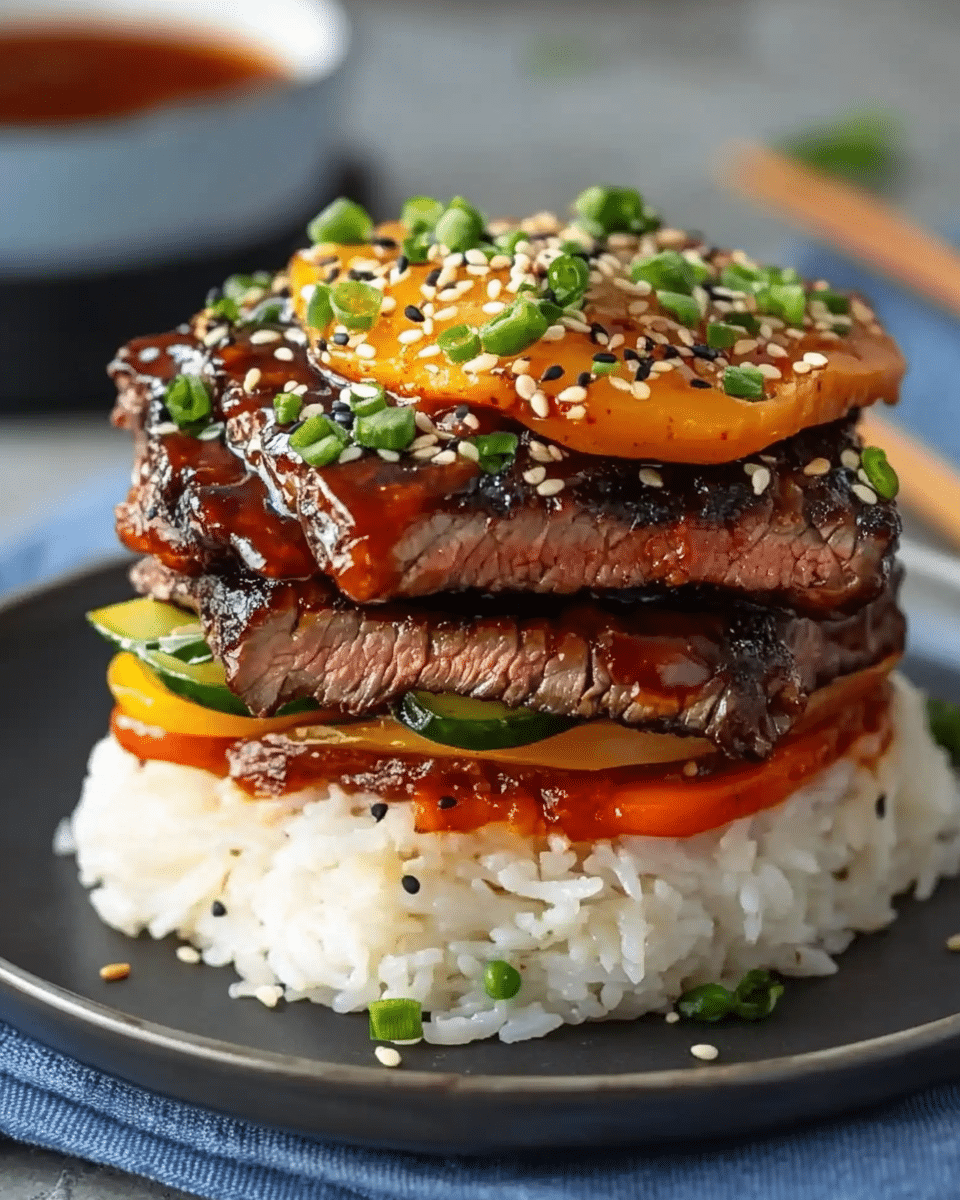The Korean BBQ Beef Rice Stack is a delicious, visually striking dish that layers savory, caramelized beef with perfectly steamed rice and spicy gochujang sauce. It’s an easy yet impressive meal, combining the flavors of Korean BBQ with a modern twist. By layering these components in a stack, you not only elevate the dish visually but also infuse each bite with a combination of umami, sweet, and spicy flavors. This dish is perfect for dinner parties or a fun, elevated weeknight meal.
Full Recipe:
Ingredients
For the Korean BBQ Beef
-
1 lb thinly sliced ribeye or sirloin beef
-
1/4 cup soy sauce (low sodium if desired)
-
2 tbsp brown sugar (or honey)
-
1 tbsp sesame oil
-
1 tbsp minced garlic
-
1 tbsp grated ginger
-
2 tbsp gochujang (Korean red pepper paste)
-
1 tbsp rice vinegar
-
2 green onions (for garnish)
For the Rice Stack
-
2 cups short-grain white rice (or brown rice for a healthier option)
-
2 1/2 cups water
-
1 tbsp butter or sesame oil
-
1 tsp salt
For Garnish
-
1 cup kimchi (chopped)
-
2 tbsp toasted sesame seeds
-
2 green onions (thinly sliced)
-
1 tbsp gochugaru (optional, Korean red pepper flakes)
-
1 fried egg (optional, for added richness)
Directions
-
Marinate the Beef:
In a medium bowl, whisk together soy sauce, brown sugar, sesame oil, garlic, ginger, gochujang, and rice vinegar. Add the sliced beef and toss to coat. Cover and marinate for at least 30 minutes, or overnight for deeper flavor. -
Cook the Rice:
Rinse the rice under cold water until the water runs clear. In a medium saucepan, combine the rinsed rice, water, butter (or sesame oil), and salt. Bring to a boil, then reduce the heat, cover, and simmer for 15-18 minutes. Once done, let it sit covered for 10 minutes. -
Cook the Beef:
Heat a large skillet or grill pan over medium-high heat. Remove the beef from the marinade and cook in batches for 2-3 minutes, or until browned and caramelized. Remove from the skillet and set aside. -
Assemble the Stack:
Use a round mold or an empty can with both ends removed to create the stack. On a serving plate, start with a layer of rice (about 1/2 cup), pressing it down gently with the back of a spoon. Add a layer of cooked beef, then another layer of rice, and top with more beef. Repeat until you have a beautifully layered stack. -
Garnish and Serve:
Carefully lift the mold off to reveal the stacked dish. Garnish with chopped kimchi around the base, toasted sesame seeds, sliced green onions, and a sprinkle of gochugaru. Top with a fried egg for extra indulgence.
Nutrients (Approximate per serving)
-
Calories: 485 kcal
-
Protein: 27g
-
Carbohydrates: 58g
-
Fat: 18g
-
Saturated Fat: 4g
-
-
Sodium: 890mg
-
Fiber: 2g
What is Korean BBQ?
Korean BBQ refers to a popular method of grilling meat, typically beef, pork, or chicken, on a tabletop grill. The meat is often marinated in a combination of soy sauce, sesame oil, garlic, ginger, and other spices before being grilled to perfection. It is usually served with a variety of side dishes, or banchan, including kimchi, pickled vegetables, and steamed rice. The flavors are typically bold, savory, and slightly smoky, making Korean BBQ a crowd-pleaser in both Korean culture and worldwide.
The BBQ method in Korean cuisine differs from Western BBQs in that it focuses more on grilling smaller cuts of meat, often with a touch of sweetness or spice. The combination of the marinade and grilling process results in a caramelized exterior, while keeping the meat tender and juicy on the inside. These same flavors have been incorporated into the Korean BBQ Beef Rice Stack, which offers a contemporary spin on traditional Korean BBQ by combining the delicious grilled beef with a fluffy bed of rice, creating a layered dish that is both satisfying and visually appealing.
The Key Components of the Dish
The Korean BBQ Beef Rice Stack consists of three main components: the beef, the rice, and the garnish. Each plays an important role in contributing to the dish’s overall flavor profile and texture.
Beef: A Rich, Caramelized Delight
The star of the Korean BBQ Beef Rice Stack is the beef, typically made from ribeye or sirloin. These cuts are chosen because of their tenderness and ability to absorb marinades. The beef is marinated in a mixture of soy sauce, brown sugar, sesame oil, garlic, ginger, and gochujang. Gochujang, a Korean red pepper paste, is a staple in many Korean dishes and brings a delightful balance of spice and umami to the marinade. The addition of rice vinegar enhances the marinade with a touch of acidity, cutting through the richness of the beef.
After marinating, the beef is quickly seared in a hot skillet or grilled, which caramelizes the sugars in the marinade, creating a savory, slightly sweet, and smoky flavor. The beef’s tender texture combined with its rich flavor makes it the perfect complement to the rice in the stack.
Rice: The Foundation of the Stack
The rice used in this dish is typically short-grain white rice, which is sticky and slightly chewy—ideal for forming neat layers in the stack. The rice is seasoned with butter or sesame oil and a pinch of salt to bring out its natural flavor and enhance its texture. While the rice serves as the base for the beef, it also acts as a neutral canvas to balance the rich and spicy flavors of the beef and sauce. For a healthier alternative, you can use brown rice, which adds a nutty flavor and extra fiber to the dish. However, the short-grain white rice is preferred in Korean cuisine because of its ability to clump together and form stable layers in the stack.
Garnishes: Adding Flavor and Visual Appeal
The garnishes in this dish elevate it not only in terms of flavor but also in terms of presentation. A sprinkle of toasted sesame seeds adds a subtle crunch and nutty flavor, while the sliced green onions provide a fresh, crisp contrast to the richness of the beef. Kimchi, a fermented Korean side dish made from cabbage and radishes, adds a tangy and spicy element that pairs beautifully with the savory beef. For those who enjoy an extra layer of flavor, gochugaru (Korean red pepper flakes) can be added as a garnish, contributing additional heat and a pop of color.
An optional fried egg on top of the stack can add a touch of richness, with the runny yolk providing a luscious texture that enhances the dish even further. The combination of these garnishes creates a colorful, appetizing visual, making the dish as enjoyable to look at as it is to eat.
Why This Dish Is So Appealing
The Korean BBQ Beef Rice Stack has gained popularity due to its delightful combination of flavors and textures. The beef is savory and slightly sweet, with a bit of heat from the gochujang, while the rice provides a mild, comforting backdrop that allows the beef to shine. The garnishes, including kimchi and sesame seeds, introduce a contrast of textures and flavors that keep each bite interesting. The dish is also visually stunning, with the layers of rice and beef forming a perfect stack that looks impressive without requiring advanced cooking skills.
This dish is versatile and can be easily adjusted to suit different tastes. For example, you can make it spicier by adding more gochujang or gochugaru, or you can make it milder by adjusting the amount of soy sauce and garlic in the marinade. The fried egg is optional but highly recommended for those who enjoy a touch of richness. It’s a meal that works well for dinner parties, casual gatherings, or even a cozy weeknight meal.
Cultural Significance and Global Popularity
While Korean BBQ is a traditional cooking method, dishes like the Korean BBQ Beef Rice Stack have introduced Korean cuisine to a global audience. The fusion of traditional flavors with modern plating techniques makes the dish accessible to people from various cultures while still honoring the roots of Korean culinary traditions. The rise of Korean cuisine worldwide can also be attributed to the increasing popularity of Korean dramas and K-pop, which have piqued interest in Korean culture, including its food.
The appeal of Korean BBQ lies in the complex layering of flavors. The rich, marinated beef, the smoky char from grilling, the spicy kick from gochujang, and the subtle sweetness of the marinade create a dynamic taste profile. In a world where global cuisine is celebrated, the Korean BBQ Beef Rice Stack is a perfect example of how food can transcend borders and bring people together to enjoy delicious, well-crafted meals.
Conclusion
The Korean BBQ Beef Rice Stack is a dish that brings together the best elements of Korean BBQ and modern culinary techniques. The combination of marinated beef, perfectly cooked rice, and flavorful garnishes results in a visually appealing and mouthwatering meal. It’s easy to prepare, adaptable to different tastes, and sure to impress anyone who experiences it. Whether you’re serving it at a dinner party or enjoying it as a weeknight meal, this dish is a delightful way to introduce the bold, savory flavors of Korean BBQ into your home. By stacking the components of this dish, you not only elevate the presentation but also create an unforgettable dining experience.






